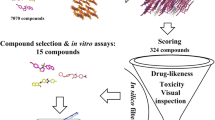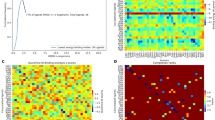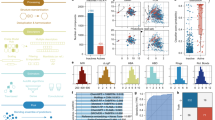Abstract
Octopus is an automated workflow management tool that is scalable for virtual high-throughput screening (vHTS). It integrates MOPAC2016, MGLTools, PyMOL, and AutoDock Vina. In contrast to other platforms, Octopus can perform docking simulations of an unlimited number of compounds into a set of molecular targets. After generating the ligands in a drawing package in the Protein Data Bank (PDB) format, Octopus can carry out geometry refinement using the semi-empirical method PM7 implemented in MOPAC2016. Docking simulations can be performed using AutoDock Vina and can utilize the Our Own Molecular Targets (OOMT) databank. Finally, the proposed software compiles the best binding energies into a standard table. Here, we describe two successful case studies that were verified by biological assay. In the first case study, the vHTS process was carried out for 22 (phenylamino)urea derivatives. The vHTS process identified a metalloprotease with the PDB code 1GKC as a molecular target for derivative LE&007. In a biological assay, compound LE&007 was found to inhibit 80% of the activity of this enzyme. In the second case study, compound Tx001 was submitted to the Octopus routine, and the results suggested that Plasmodium falciparum ATP6 (PfATP6) as a molecular target for this compound. Following an antimalarial assay, Tx001 was found to have an inhibitory concentration (IC50) of 8.2 μM against PfATP6. These successful examples illustrate the utility of this software for finding appropriate molecular targets for compounds. Hits can then be identified and optimized as new antineoplastic and antimalarial drugs. Finally, Octopus has a friendly Linux-based user interface, and is available at www.drugdiscovery.com.br.

Octopus: A platform for inverse virtual screening (IVS) to search new molecular targets for drugs.







Similar content being viewed by others
References
Ferreira RS, Oliva G, Andricopulo AD (2011) Integrating virtual and high-throughput screening: opportunities and challenges in drug research and development. Quim Nov. 34:1770–1778. doi:10.1590/S0100-40422011001000010
Bennani YL (2011) Drug discovery in the next decade: Innovation needed ASAP. Drug Discov Today 16:779–792. doi:10.1016/j.drudis.2011.06.004
Keserü GM, Makara GM (2009) The influence of lead discovery strategies on the properties of drug candidates. Nat Rev Drug Discov 8:203–212. doi:10.1038/nrd2796
Kitchen DB, Decornez H, Furr JR, Bajorath J (2004) Docking and scoring in virtual screening for drug discovery: methods and applications. Nat Rev Drug Discov 3:935–949. doi:10.1038/nrd1549
Katsuno K, Burrows JN, Duncan K et al (2015) Hit and lead criteria in drug discovery for infectious diseases of the developing world. Nat Rev Drug Discov 14:751–8. doi:10.1038/nrd4683
Andricopulo A, Ferreira L (2014) Medicinal chemistry approaches to neglected diseases drug discovery. J Mod Med Chem 2:20–31. doi:10.12970/2308-8044.2014.02.01.4
Polgar T, Keseru GM (2011) Integration of virtual and high throughput screening in lead discovery settings. Comb Chem High Throughput Screen 14:889–897. doi:10.2174/138620711797537148
Ripphausen P, Nisius B, Bajorath J (2011) State-of-the-art in ligand-based virtual screening. Drug Discov Today 16:372–376. doi:10.1016/j.drudis.2011.02.011
Sousa SF, Cerqueira NMFSA, Fernandes PA, Ramos MJ (2010) Virtual screening in drug design and development. Comb Chem High Throughput Screen 13:442–453. doi:10.2174/138620710791293001
Berman HM, Kleywegt GJ, Nakamura H, Markley JL (2013) The future of the Protein Data Bank. Biopolymers 99:218–22. doi:10.1002/bip.22132
Irwin JJ, Shoichet BK (2005) ZINC—a free database of commercially available compounds for virtual screening. J Chem Inf Model 45:177–182. doi:10.1021/ci049714+
Ferreira L, dos Santos R, Oliva G, Andricopulo A (2015) Molecular docking and structure-based drug design strategies. Molecules 20:13384–13421. doi:10.3390/molecules200713384
Morris G, Huey R (2009) AutoDock4 and AutoDockTools4: automated docking with selective receptor flexibility. J Comput Chem 30:2785–2791. doi:10.1002/jcc.21256.AutoDock4
Elokely KM, Doerksen RJ (2013) Docking challenge: protein sampling and molecular docking performance. J Chem Inf Model 53:1934–1945
Jaghoori MM, Bleijlevens B, Olabarriaga SD (2016) 1001 ways to run AutoDock Vina for virtual screening. J Comput Aided Mol Des 30:237–249. doi:10.1007/s10822-016-9900-9
Hui-fang L, Qing S, Jian Z, Wei F (2010) Evaluation of various inverse docking schemes in multiple targets identification. J Mol Graph Model 29:326–330. doi:10.1016/j.jmgm.2010.09.004
Carregal AP, Comar M, Alves SN et al (2012) Inverse virtual screening studies of selected natural compounds from Cerrado. Int J Quantum Chem 112:3333–3340. doi:10.1002/qua.24205
Rognan D (2010) Structure-based approaches to target fishing and ligand profiling. Mol Inform 29:176–187. doi:10.1002/minf.200900081
Stewart JPP (2012) MOPAC2012. Stewart Computational Chemistry, Colorado Springs
DeLano WL (2002) The PyMOL molecular graphics system, version 1.8. Schrödinger, LLC, New York. http://www.pymol.org. doi: 10.1038/hr.2014.17
Trott O, Olson AJ (2010) AutoDock Vina: improving the speed and accuracy of docking with a new scoring function, efficient optimization, and multithreading. J Comput Chem 31:455–461. doi:10.1002/jcc.21334
Forli S, Piche ME, Sanner M et al (2016) Computational protein–ligand docking and virtual drug screening with the AutoDock suite. Nat Protoc 5:905–919. doi:10.1038/nbt.3121.ChIP-nexus
Carregal AP, Comar Jr MC, Taranto AG (2013) Our Own Molecular Targets data bank (OOMT). Biochem Biotechnol Reports 2:14–16
Carregal AP, Maciel FV, Carregal JB, et al. (2016) Docking-based virtual screening of Brazilian natural compounds using OOMT as the pharmacological target database. J Mol Model (submitted)
Haga JH, Ichikawa K, Date S (2016) Virtual screening techniques and current computational infrastructures. Curr Pharm Des 22:3576–84
Harrison RL (2010) Introduction to Monte Carlo simulation. AIP Conf Proc 1204:17–21. doi:10.1063/1.3295638.Introduction
Verdonk ML, Cole JC, Hartshorn MJ et al (2003) Improved protein–ligand docking using GOLD. Proteins Struct Funct Genet 52:609–623. doi:10.1002/prot.10465
Taylor JS, Burnett RM (2000) DARWIN: a program for docking flexible molecules. Proteins Struct Funct Genet 41:173–191. doi:10.1002/1097-0134(20001101)41:2<173::AID-PROT30>3.0.CO;2-3
Ruiz-Carmona S, Alvarez-Garcia D, Foloppe N et al (2014) rDock: a fast, versatile and open source program for docking ligands to proteins and nucleic acids. PLoS Comput Biol 10:1–7. doi:10.1371/journal.pcbi.1003571
Chemical Computing Group Inc. (2004) Molecular Operating Environment (MOE). Sci Comput Instrum 22:32
Abagyan R, Totrov M, Kuznetsov D (1994) ICM—a new method for protein modeling and design: applications to docking and structure prediction from distorted native conformation. J Comput Chem 15:488–506
Taylor RD, Jewsbury PJ, Essex JW (2002) A review of protein–small molecule docking methods. J Comput Aided Mol Des 16:151–166. doi:10.1023/A:1020155510718
McMartin C, Bohacek RS (1997) QXP: powerful, rapid computer algorithms for structure-based drug design. J Comput Aided Mol Des 11:333–344. doi:10.1023/a:1007907728892
Friesner RA, Banks JL, Murphy RB et al (2004) Glide: a new approach for rapid, accurate docking and scoring. 1. Method and assessment of docking accuracy. J Med Chem 47:1739–1749. doi:10.1021/jm0306430
Hu B, Lill MA (2014) PharmDock: a pharmacophore-based docking program. J Cheminform 6:1–14. doi:10.1186/1758-2946-6-14
Accelrys Software Inc. (2013) Discovery Studio Modeling Environment, release 4.1. Accelrys Software Inc., San Diego
McGann M (2011) FRED pose prediction and virtual screening accuracy. J Chem Inf Model 51:578–596. doi:10.1021/ci100436p
Kearsley SK, Underwood DJ, Sheridan RP, Miller MD (1994) Flexibases: a way to enhance the use of molecular docking methods. J Comput Aided Mol Des 8:565–582. doi:10.1007/BF00123666
McGann M (2012) FRED and HYBRID docking performance on standardized datasets. J Comput Aided Mol Des 26:897–906. doi:10.1007/s10822-012-9584-8
Schnecke V, Kuhn LA (2000) Virtual screening with solvation and ligand-induced complementarity. Perspect Drug Discov Des 20:171–190. doi:10.1023/A:1008737207775
Zsoldos Z, Reid D, Simon A et al (2007) eHiTS: a new fast, exhaustive flexible ligand docking system. J Mol Graph Model 26:198–212. doi:10.1016/j.jmgm.2006.06.002
Spitzer R, Jain AN (2012) Surflex-Dock: docking benchmarks and real-world application. J Comput Aided Mol Des 26:687–699. doi:10.1007/s10822-011-9533-y
Lang PT, Brozell SR, Mukherjee S et al (2009) DOCK 6: combining techniques to model RNA—small molecule complexes. RNA 15:1219–1230. doi:10.1261/rna.1563609.HIV
Pang YP, Perola E, Xu R, Prendergast FG (2001) EUDOC: a computer program for identification of drug interaction sites in macromolecules and drug leads from chemical databases. J Comput Chem 22:1750–1771. doi:10.1002/jcc.1129
Rarey M, Kramer B, Lengauer T, Klebe G (1996) A fast flexible docking method using an incremental construction algorithm. J Mol Biol 261:470–89. doi:10.1006/jmbi.1996.0477
Allen WJ, Balius TE, Mukherjee S et al (2015) DOCK 6: impact of new features and current docking performance. J Comput Chem 36:1132–1156. doi:10.1002/jcc.23905
Kramer B, Rarey M, Lengauer T (1999) Evaluation of the FlexX incremental construction algorithm for protein–ligand docking. Proteins Struct Funct Genet 37:228–241. doi:10.1002/(SICI)1097-0134(19991101)37:2<228::AID-PROT8>3.0.CO;2-8
Welch W, Ruppert J, Jain AN (1996) Hammerhead: fast, fully automated docking of flexible ligands to protein binding sites. Chem Biol 3:449–462. doi:10.1016/S1074-5521(96)90093-9
Eisen MB, Wiley DC, Karplus M, Hubbard RE (1994) HOOK: a program for finding novel molecular architectures that satisfy the chemical and steric requirements of a macromolecule binding site. Proteins Struct Funct Genet 19:199–221. doi:10.1002/prot.340190305
Tripos International (2011) SYBYL-X 1.2. Tripos International, St. Louis
Antes I (2010) DynaDock: a new molecular dynamics-based algorithm for protein–peptide docking including receptor flexibility. Proteins Struct Funct Bioinf 78:1084–1104. doi:10.1002/prot.22629
Huang S-Y, Grinter SZ, Zou X (2010) Scoring functions and their evaluation methods for protein-ligand docking: recent advances and future directions. Phys Chem Chem Phys 12:12899–908. doi:10.1039/c0cp00151a
Breda A, Basso LA, Santos DS, de Azevedo Jr WF (2008) Virtual screening of drugs: score functions, docking, and drug design. Curr Comput Aid Drug Des 4:265–272. doi:10.2174/157340908786786047
Stewart JJP (2016) MOPAC2016. Stewart Computational Chemistry, Colorado Springs. http://openmopac.net/MOPAC2016.html
Dutra JDL, Filho MAM, Rocha GB et al (2013) Sparkle/PM7 lanthanide parameters for the modeling of complexes and materials. J Chem Theory Comput 9:3333–3341. doi:10.1021/ct301012h
Gasteiger J, Marsili M (1980) Iterative partial equalization of orbital electronegativity—a rapid access to atomic charges. Tetrahedron 36:3219–3228. doi:10.1016/0040-4020(80)80168-2
Forli S, Huey R, Pique ME et al (2016) Computational protein–ligand docking and virtual drug screening with the AutoDock suite. Nat Protoc 11:905–919. doi:10.1038/nprot.2016.051
Nunes RR, dos Costa MS, dos Santos BR et al (2016) Successful application of a virtual screening and molecular dynamics simulation against antimalarial molecular targets. Mem Inst Oswaldo Cruz 111:721–730. doi:10.1590/0074-02760160207
Rowsell S, Hawtin P, Minshull CA et al (2002) Crystal structure of human MMP9 in complex with a reverse hydroxamate inhibitor. J Mol Biol 319:173–181. doi:10.1016/S0022-2836(02)00262-0
Accelrys Software Inc. (2015) Discovery Studio modeling environment, release 4.5. Accelrys Software Inc., San Diego
RIMA R, Kuribayashi JS, Borges Júnior PC et al (2010) Inibição de metaloproteinases por extratos aquosos de Aloe vera, Annona muricata e chá preto. Biosci J 26:121–127
Adhikari A, Kalluraya B, Sujith KV et al (2012) Synthesis, characterization and pharmacological study of 4,5-dihydropyrazolines carrying pyrimidine moiety. Eur J Med Chem 55:467–474. doi:10.1016/j.ejmech.2012.07.002
Guimarães DSM, Da Fonseca AL, Batista R et al (2015) Structure-based drug design studies of the interactions of ent-kaurane diterpenes derived from Wedelia paludosa with the Plasmodium falciparum sarco/endoplasmic reticulum Ca2+−ATPase PfATP6. Mem Inst Oswaldo Cruz 110:255–258. doi:10.1590/0074-02760140415
Acknowledgements
The authors are grateful for the support provided by the Foundation for Research Support of Minas Gerais (FAPEMIG APQ-00557-14 and APQ-02860-16), the Higher Level Personnel Improvement Commission (CAPES), the National Research Council (CNPq UNIVERSAL 449984/2014-1), and Graduated Programs in Pharmaceutical Sciences (PPGCS) and Biotechnology (PPGBiotec) from the Federal University of Sao Joao del Rei (UFSJ) and the Federal Center for Technological Education of Minas Gerais (CEFET-MG). A.G. Taranto is grateful to Mr. Pedro for the “Ignorância Zero” initiative.
Author information
Authors and Affiliations
Corresponding author
Additional information
This paper belongs to Topical Collection Brazilian Symposium of Theoretical Chemistry (SBQT 2015)
Rights and permissions
About this article
Cite this article
Maia, E.H.B., Campos, V.A., dos Reis Santos, B. et al. Octopus: a platform for the virtual high-throughput screening of a pool of compounds against a set of molecular targets. J Mol Model 23, 26 (2017). https://doi.org/10.1007/s00894-016-3184-9
Received:
Accepted:
Published:
DOI: https://doi.org/10.1007/s00894-016-3184-9




